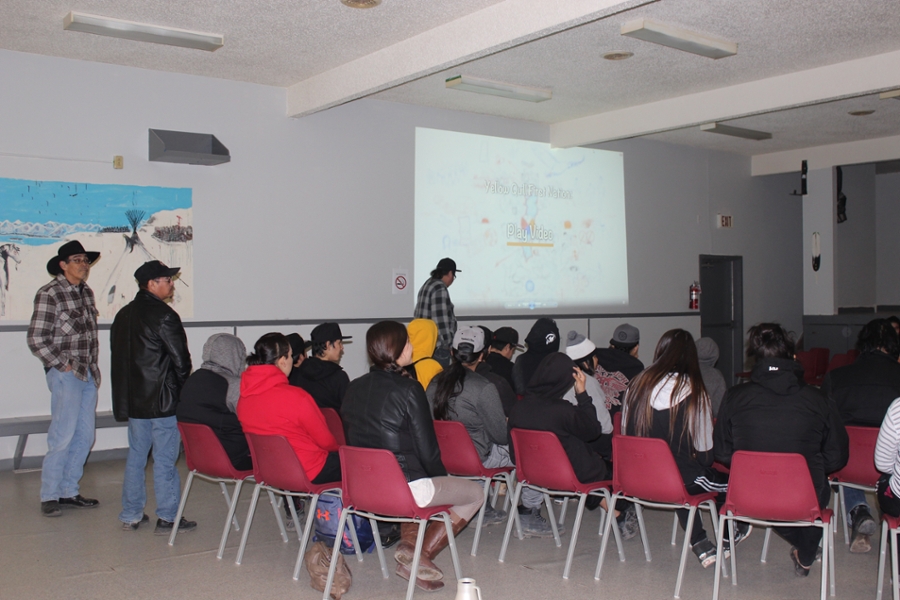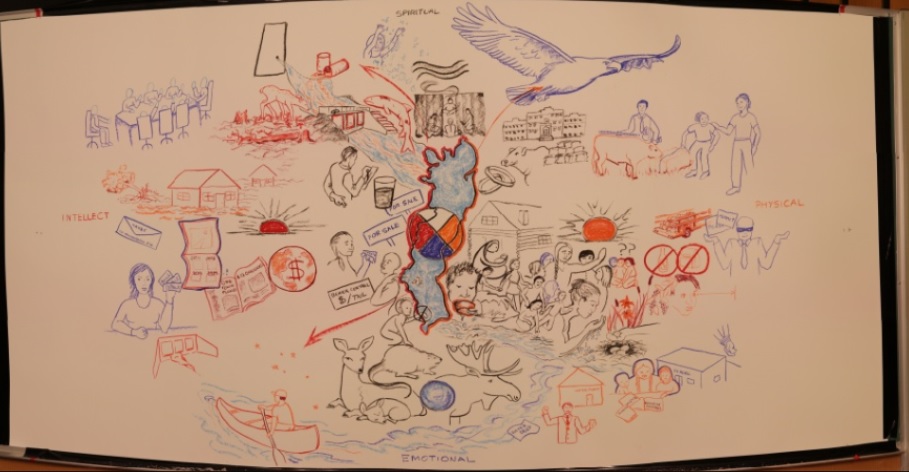Bridging the gap
An animated video produced collaboratively by a University of Saskatchewan (U of S) research team and the Yellow Quill First Nation gives voice to the struggles the community has endured due to regulations that left a legacy of damage in their waterways.
By Cat Bonner
“The interests of Indigenous people have traditionally had little voice to influence or sanction laws of water protection, regulation, and enforcement on First Nations land in Canada,” said School of Public Health (SPH) Associate Professor and lead researcher Lalita Bharadwaj. “It is time we gather to hear the voices from these communities, and to share these voices widely”.
A moving account which uses animated drawing and narration to charter the history and sacredness of the community’s waters, the video was launched on Yellow Quill First Nation at a special event on April 11.
A receptive audience of over 50 Elders, youth and community members came together for food and a first screening of the video, where local artist Cheryl Buckmaster, who was chosen to draw the symbols for the video’s animations, gifted her original drawing to the community.
The video is part of a one-year collaborative Indigenous knowledge mobilization research project initiated in May 2016 titled Spirit, Safety and a Stand-off, led by Bharadwaj and funded by the Water, Economics, Policy, and Governance Network (WEPGN) at Brock University.
The research team’s ultimate goal was to present their findings in a way that reflected the Yellow Quill First Nation culture and traditions and engaged community members, especially youth, explained SPH Research Associate Lori Bradford.
“We wanted to find a way to translate results that supported the community’s sacred knowledge and storytelling traditions,” she said. “The video is designed to capture and share the knowledge of the waters at Yellow Quill from the Elders point-of-view, in a blending of traditional Indigenous storytelling and fine art.”
The community chose video as the means of presentation after seeing a previous whiteboard animation project produced by Bharadwaj and Bradford in 2015 on changes to the Slave River and Delta, told through the memories of South Slave region Elders.

Bharadwaj’s research team worked closely with the Yellow Quill Chief and Council to produce the video’s script and corresponding symbols, inspired by interviews with the community’s Elders, who recalled a lifetime of changes and challenges with the community’s water.
Using traditional charcoal and cotton rag paper, and the colour palette of the Salteaux First Nation’s cycle of life, artist Buckmaster was filmed by the U of S Education Media and Production unit as she drew out the symbols to make the video’s animation. The narration was then recorded in on-campus production studios, with four young summer students from Yellow Quill volunteering as voice actors.
Since its launch, the video has been very well received by the Yellow Quill community.
“One of the Elders said that it puts into words what the community feels inside,” explained Bradford.
Myron Neapetung, a member of the Yellow Quill Council who worked closely on the project, said that the video will be used as a teaching tool with schools, for sharing the Yellow Quill story with other Indigenous communities, and to educate businesses coming into the community on its past and current challenges with water.
“The value of the video was explained by several Elders, the principle of the school, teachers and community members as a way to educate youth and the community, connect youth with Elders, and as a record of historical events within the community,” said Bharadwaj.
Overall, the research team is pleased with the outcome of the project, which has been beneficial to both the community and the researchers.
“We set out to advance tools for participatory knowledge mobilization with Indigenous communities in a way that works for them,” Bradford explained. “It also provides an alternative method for researchers to give back, other than a report on a shelf.”
Building respectful relationships with the Yellow Quill Chief and Council has paved the way for Bharadwaj and her team to continue working with the community in the future, and they are currently working to secure new grants to protect the community’s waters from the impacts of climate change.

